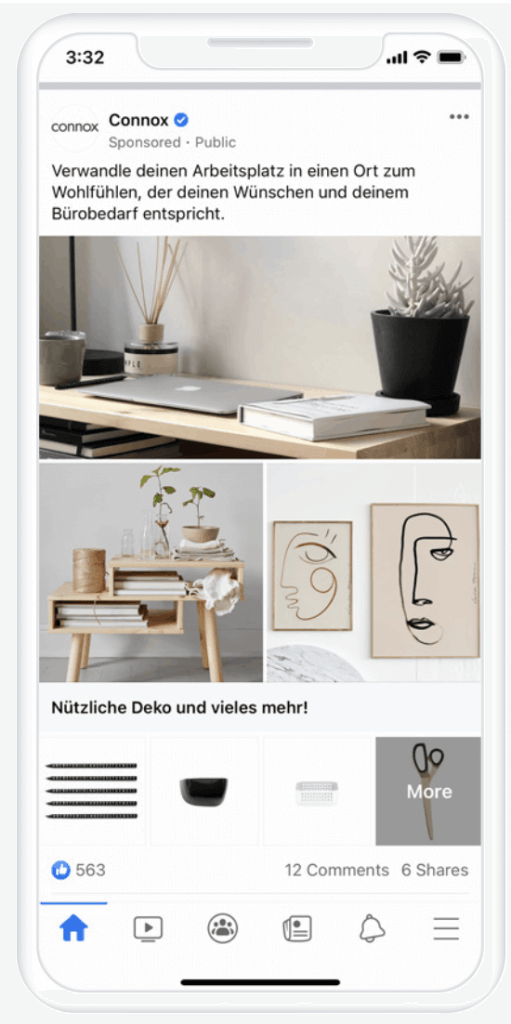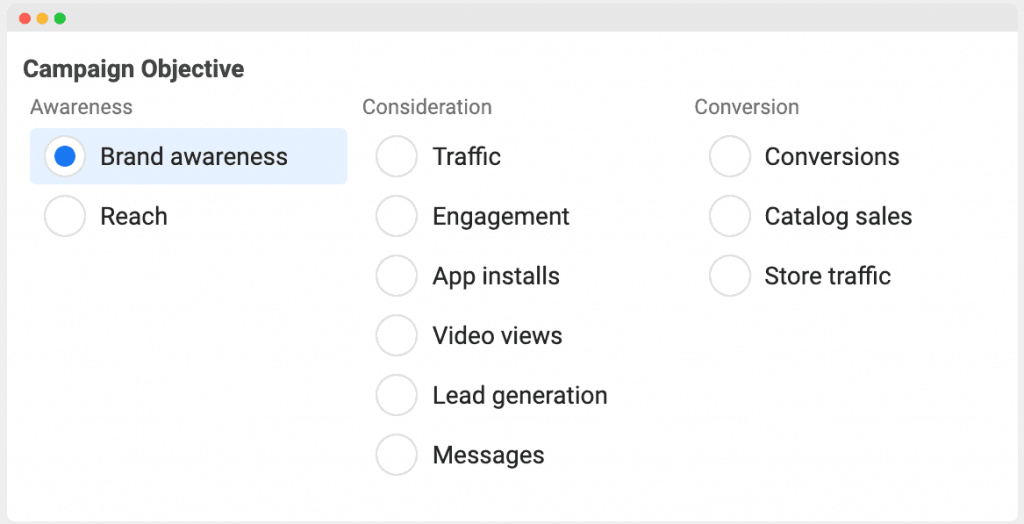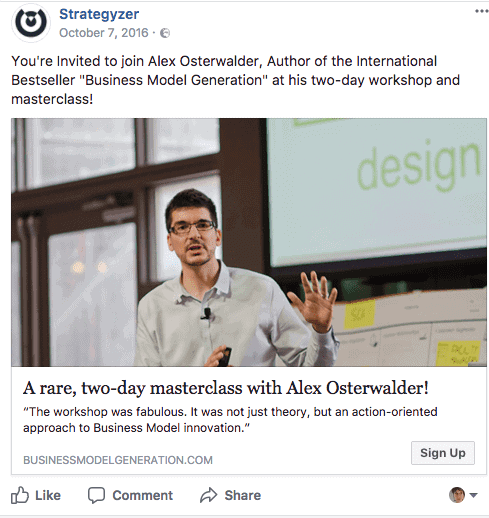Building a Facebook funnel involves multiple strategies and touchpoints depending on the stage of the customer’s journey.
If you want to learn how to take audiences from complete strangers to buyers of your product or service, you’ve come to the right place. In this article, we cover everything from what a Facebook funnel is, why you need one, and creating a full funnel advertising strategy.
What Is a Facebook Funnel?
A Facebook funnel, or Facebook sales funnel, is a series of stages that people go through to eventually become your customers. This takes place on the Facebook platform.
With a proper sales funnel in place, you’re able to create demand for your product or service and even encourage repeat sales. You can do it with organic Facebook posts and Facebook ad campaigns.
The Stages of a Facebook Funnel
The Facebook funnel consists of 3 stages that represent where your audience is in their journey.
1. Top of the Funnel (TOFU).
This is the Awareness stage. At this stage, people don’t know about your product or service yet. However, they have a problem that needs to be solved.
Your goal is to warm up your audience by providing helpful content. A common example would be sharing articles on your Facebook page, posting tips, or running ads that increase brand awareness.
The best tip for the “awareness” stage? Don’t be salesy. Instead, be helpful.
2. Middle of the Funnel (MOFU).
This is the Consideration stage. At this stage, you’re going to nurture your audience. In other words, get them to be more interested in you and start a relationship. Your goal here is to make them reach a point where they consider making a purchase.
One way that businesses can succeed is by running lead ads. They offer a free whitepaper or ebook in exchange for a prospect’s contact information – email address, phone number, and other details. These will be used for further nurturing and remarketing campaigns.
3. Bottom of the Funnel (BOFU).
This is the Conversion stage. At this stage, your aim is to get your prospects to act. That could be visiting your physical store, subscribing to your tool, or shopping your product online.
Positive buying experiences compel your customers to share your brand with others. This process creates new referrals that fill the top of your funnel with new audiences.
The Steps to Building a Facebook Sales Funnel That Works
Ready to create a Facebook funnel blueprint? Follow these steps.
1. Define your audience.
People go on Facebook to engage with their friends and share experiences. This tells us something: They’re not planning to buy something.
It’s not the same with Google where most people who use it are considering making a purchase. (Read: Google Ads vs Facebook Ads)
For that reason, it’s so important to know who your target audience on Facebook is. By doing that, you can create organic posts and ads that speak to their interests and needs.
2. Create different types of content for different stages of their journey.
You won’t be posting just one piece of content since you’re targeting people at different stages of the Facebook funnel. That means you need to plan different content types with different messages and calls to action.
Your content can include blog posts, questions, tips, inspirational messages, and so much more. If you’re not doing it yet, make sure to leverage videos. Videos increase your brand’s authenticity, helping you build a more personal connection with your viewers.
(Tip: Retarget those who’ve watched your videos on Facebook and/or Instagram. Using ConnectVideo, you can easily retarget a “super video audience” – people who’ve watched your videos at a certain duration and period.)
Awareness Stage Facebook Ad Content Ideas
- Referral contests. If you decide to do a referral contest, run a Facebook ad for it. This will increase your reach and drive more participants to your campaign.
- Helpful articles. Share posts that educate and provide value. Take, for example, Healthline’s useful resource on breathing exercises for anxiety. It’s a topic that their audience cares about. Check out their ad below:

Source: Facebook Ads Library
- Video to promote your content. Shoot a video of yourself or create one to promote another piece of content you have. In the example below, Amy Porterfield uses a video ad to encourage people to listen to her podcast episode.

Source: Facebook Ads Library
Consideration Stage Facebook Ad Content Ideas
- Free trial. A free trial would be a great offer for potential customers. They can test out your tool and know if it meets their needs – without risk.
- Host a webinar to showcase your expertise in your niche. Then run a lead ad for that webinar to increase registrations. According to Hubspot’s webinar conversion stats, webinars have helped 76% of marketers reach more leads.
- Guides/ebooks. WordStream grabs attention with a Facebook video ad to promote their latest guide. It shows the title of the ebook and a catchy CTA, “GET MY FREE GUIDE.”

Source: Facebook Ads Library
Conversion Stage Facebook Ad Content Ideas
- Customer-generated images or videos. If you’re running the usual Facebook image ad, you might want to switch things up. Show them an ad of an image or video of a customer using your product or service. User-generated content can be very persuasive. Check out the video ad below from Thrive Causemetics:

Source: Facebook Ads Library
- Carousel or collection ads for products. Carousel ads let you showcase up to 10 images or videos. Collection ads, on the other hand, look like carousel ads but are tailored to mobile devices. Both formats display your products beautifully. Here’s an example of a collection ad that generated higher sales at a lower cost for Connox, an online furniture retailer.

Source: FACEBOOK for Business
3. Select the right Facebook ad objectives.
What do you want to achieve from your Facebook ad? Selecting the right objective from the start is important. If this is your first time to run an ad, go for the objective that aligns with your business goals.
Facebook has grouped these objectives in the Ads Manager based on the 3 funnel stages:
Awareness
- Brand awareness
- Reach
Consideration
- Traffic
- Engagement
- App installs
- Video views
- Lead generation
- Messages
Conversion
- Conversions
- Catalog sales
- Store traffic

Take note that different objectives support different ad formats. For example, if you choose the “Lead generation” objective to target middle of the funnel audiences, you can use the following formats: Image, Video, Carousel, and Collection.
If you want to optimize for Traffic or Video views at the “awareness” stage, you can do that as well. Just steer clear of objectives such as Conversions, Catalog sales, and Store traffic. They do not work well for cold audiences.
4. Select your target audience.
Core audience, custom audience, lookalike audience. Which one should you target your ads to? Here’s more about each audience type:
Core audience
This is a good targeting option for “top of the funnel” prospects. Sourced directly from Facebook, this option lets you target people based on demographics, behaviors, location, interests, and connections.
To be successful at this, make sure to gather as many details as possible about your ideal customer.
For example, let’s say you run a local weekly meal delivery service. Your target audience is men and women ages 30-50. They are working professionals, preferably married, love plant-based meals, and who often avail meal delivery services using their mobile devices.
Once you have this kind of information, you should be able to easily choose from the targeting options in Ads Manager.
Custom audience
A custom audience refers to people who already expressed some interest in your business. This could be people who’ve watched at least 10 seconds of your video or longer or fans of your Facebook page.
Custom audiences are perfect for moving prospects further down your Facebook funnel.
Lookalike audience
When it comes to prospecting or identifying potential customers, target a lookalike audience. This is the type of audience that you can use to attract more people at the top of your funnel or the “awareness” stage.
All you need to do is upload a file of your best customers. Facebook recommends a group of 1,000 to 50,000.
The benefit of targeting a lookalike audience at the top of the funnel? It provides more opportunities to increase your conversion rates down the road compared to a standard audience.
Read more: Facebook Targeted Ads: How to Zero-In On Your Audience
5. Provide a great post-purchase experience.
A lot of brands think that the funnel ends after customers make a purchase. Make sure that you don’t neglect the post-purchase phase.
What takes place after people buy matters more than ever. This is your chance to reassure your new customers that they’ve made the right decision!
Here are some post-purchase strategies to consider for your funnel:
- Exclude these customers from your retargeting audience. Don’t show them the same ads you used to convert them in the first place.
- Reward them with discounts and exclusive offers. Offer greater incentives to high-spending customers. This keeps them coming back as repeat customers.
- If possible, encourage your customers to contribute user-generated content so that you can use it for future ad campaigns. You can also ask for testimonials to boost the social proof of your ads.
How to Move Your Leads Down the Funnel Faster
Now that you have an idea on creating a funnel for your business using Facebook, here’s how to convert your audience faster.
1. Promote your best content.
Have you had great results with a piece of content? Don’t let it gather dust in the corner. It could be a success story of your customer (case study), a video, or a viral blog post. If it resonated well with your audience, there’s a high chance it will also resonate with a cold ad audience.
💎Tip: Avoid boosting Facebook posts. Use ConnectAutomate to identify your best-performing organic posts based on certain parameters such as post type and engagement rate. Then, ConnectAutomate will turn them into Facebook ads.
2. The devil is in the details. Run tests as much as possible.
Conversions can increase or decrease because of small details in your Facebook ad. That could be your ad image, colors, word choice, or length of your ad copy.
AdEspresso shared a split test example from Strategyzer. Their first ad campaign cost them $4,433.53 in around 3 weeks and they got only 1 sale. Here’s the ad that they ran:

Image credit: AdEspresso
But by changing the tone and length of the copy, the ad generated 92 event purchases with an average CPA of $123.45. Changing the copy alone reduced the cost by 96.72%!
3. Make sure that your landing page has a great user experience.
You may be nailing your Facebook ads, but not your landing pages. This might be the case when people interact with your ads but don’t fill out your form or convert.
Picture this scenario: You have an enticing ad that offers a 50% discount. It has a great visual and copy. But as soon as a prospect clicks through, they cannot find the 50% discount on the page. There’s not even a chatbox where they can get help.
This leads to poor user experiences, ultimately affecting your conversions. See to it that your landing page aligns with your ad and is fully functional.
Read more: How to Create Facebook Landing Pages That Convert
Final Thoughts
Use these tips to build a Facebook funnel template that grows your business. If you’re promoting different offers to different audiences, you may need multiple funnels.
That is why before running Facebook ad campaigns, map out your customer’s journey. Know who to target, your objective, ad message, offer, and more. Need help with scaling your Facebook ads? Try our tools at Connectio.
(Cover image: Business vector created by vectorjuice – www.freepik.com)

